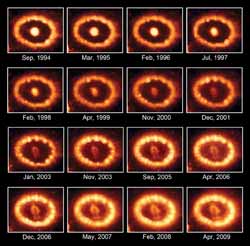Exploding star shines brighter

Caption The images were captured in the red segment of the visible spectrum. However, the colours were added afterward and do not correspond to what we would see with our eyes. Different scales were used for the ring and the rest of the image to make details stand out more clearly. Stockholm university<br>
“Our study shows that the luminosity declined until about 2001 owing to radioactive disintegration of compounds formed by the explosion. Over the last ten years, however, it began to shine more brightly again,” says Josefin Larsson at the Department of Astronomy.
“In the article we show that the increase is a result of x-ray radiation from the surrounding gas ring shining on the supernova. The change in the dominant energy source marks the transition from a supernova to what we call a supernova remnant.”
A supernova is the extremely bright explosion that occurs when a star of high density dies. The outer parts of the star are slung outward, while the innermost part forms a neutron star or a black hole. In the explosion, heavy elements are formed that subsequently come to be parts of new stars and planets.
”Supernova 1987A exploded in our neighbouring galaxy the Large Magellanic Cloud roughly 24 years ago. Since the supernova is so close, we have been able to study the consequences of the explosion with great precision for a long time with the aid of the Hubble Space Telescope,” says Larsson.
Images of Supernova 1987A taken with the Hubble Space Telescope between 1994 and 2009 show that what is shining in the middle are the remains of the star that exploded, while the ring consists of gas emitted from the star tens of thousands of years prior to the explosion. It can clearly be seen how the material that was sent out in the explosion is expanding and changing in luminosity over time.
The scientists from Stockholm University that took part in the project are Josefin Larsson, Claes Fransson, Göran Östlin, Per Gröningsson, Anders Jerkstrand, Cecilia Kozma, Jesper Sollerman, and Peter Lundqvist.
Further information
Josefin Larsson at the Department of Astronomy, Oskar Klein Centre, Stockholm University, phone: +46 (0)8-5537 8512, e-mail josefin.larsson@astro.su.se
Weitere Informationen:
http://www.nature.com/nature/journal/vaop/ncurrent/full/nature10090.html (Article in nature: X-ray illumination of the ejecta of supernova 1987A)
Media Contact
All latest news from the category: Physics and Astronomy
This area deals with the fundamental laws and building blocks of nature and how they interact, the properties and the behavior of matter, and research into space and time and their structures.
innovations-report provides in-depth reports and articles on subjects such as astrophysics, laser technologies, nuclear, quantum, particle and solid-state physics, nanotechnologies, planetary research and findings (Mars, Venus) and developments related to the Hubble Telescope.
Newest articles

Innovative 3D printed scaffolds offer new hope for bone healing
Researchers at the Institute for Bioengineering of Catalonia have developed novel 3D printed PLA-CaP scaffolds that promote blood vessel formation, ensuring better healing and regeneration of bone tissue. Bone is…

The surprising role of gut infection in Alzheimer’s disease
ASU- and Banner Alzheimer’s Institute-led study implicates link between a common virus and the disease, which travels from the gut to the brain and may be a target for antiviral…

Molecular gardening: New enzymes discovered for protein modification pruning
How deubiquitinases USP53 and USP54 cleave long polyubiquitin chains and how the former is linked to liver disease in children. Deubiquitinases (DUBs) are enzymes used by cells to trim protein…


